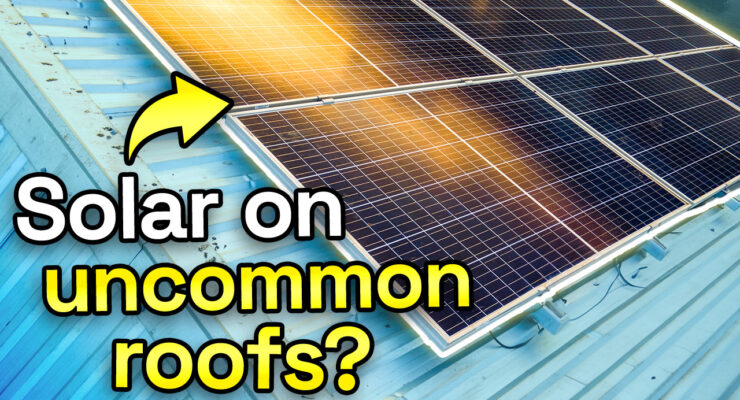Fast read
Solar panel installation on various roof types might bring particular difficulties. Such as greater installation prices, longer installation times, and the requirement for specialised tools and equipment.
For instance, working with slate roofing can be more time-consuming and delicate, and it may be necessary to utilise tile brackets or hanger bolts that need to be watertight. Contrarily, flat roofs can accommodate solar panels by adding ballast, such as concrete blocks, to prevent damage to the roof's waterproof membrane.
While asbestos roof tiles may require the use of a roof safety system, corrugated iron roofs may require specialised mounting brackets. Consulting a qualified installer when installing solar panels and considering your roof's particular characteristics is important.
How do I install solar on different roof types?
More than 3.3 million homes in Australia have solar panels, and their popularity is still increasing. As more and more people look into getting a solar system of their own, they are concerned that their roof type can affect the installation process and the panels’ performance.
Standard metal roofing or terracotta tiles are extremely suitable for installations. But roofs with slate tiles, a concrete slab, and asbestos sheeting or roof tiles containing asbestos present unique challenges. They are:
1. Slate roofs
Slate roof types are popular in Federation homes and win out on aesthetic appearance and durability. But can you install solar systems on them?
Some installers try to avoid roofs with brittle and slate tiles as the challenge to keep slate roofs watertight is higher than on standard roof tile or metal sheeting roofs. So if you have slate roof tiles, expect a slightly higher installation cost than a conventional roof.
Nails hold slate roof tiles in place and have a diminished working life because of corrosion. If the nails in the slate roof are extremely old, renail the slate roof before installing solar panels.
The solar installation process for slate roofs uses different tile brackets or hanger bolts that go through the slate tiles and must be waterproof. A more time-consuming process, care needs to be taken on the existing slates not to break or displace existing tiles.

Be aware that because of the potentially more time-consuming and fragile nature of slate roofs. The installation process can consume up to 3 times longer than on a standard roof. In addition, the labour costs will be higher, so ensure you get a few quotes from different installers before selecting one. Also, double-check their slate roof experience and maybe even ask for addresses where they have installed systems on such roofs in the broader neighbourhood.
Having much experience installing slate tile roofs is more important than a low price. Also, enquire about black panels and black railing, as this will look excellent on a slate roof.
2. Concrete roofs
Flat concrete roof types are regularly used to have a solar system installed on them. But one needs to be careful not to damage the waterproof membrane of the slab. Their most popular method to install on such roofs and to avoid penetrating the surface is with the help of ballast.
In the early days of solar, plastic trays, usually slopping into a northerly direction to maximise output, were filled with rocks or pebbles and then the panels were mounted to those heavy trays. Concrete blocks are the most popular ballast to hold the solar system in place.
The array can withstand extreme wind forces by regularly placing these concrete blocks across the roof. At the same time, no roof penetration is required. Unfortunately, such roof penetrations are often difficult to seal permanently for decades against water ingress. For this reason, no drilling into the concrete surface is preferred.
When working out how much concrete block ballast to use, the system designer and engineers have to calculate the structural capacity of the concrete roof, its actual shape, direction, the height of the building, likely wind load, and the size of the solar system. Usually, the solar framing system supplier will also supply calculations and information to assist the design process.

Areas of the system close to outside walls usually require more ballast than the more protected sections inside the array. Racking manufacturers have, over the years, improved the framing design via interlocking elements. This has resulted in less ballast being required. However, ensuring the concrete blocks are of excellent quality is important, as exposure to the sun and heavy rain with resultant moisture, UV, and heat can lead to deterioration and cracking over the years.
3. Asbestos roof
Homeowners with an asbestos roof, while theoretically solar can be installed, would benefit in the long run from replacing the asbestos sheeting with a new roof before installing solar.
Many asbestos sheeting roofs are over 50 years old and are coming to the end of their useful life, as quality solar panels can have a life span of 25 years. If one installs asbestos sheeting in as little as 5 to 8 years, the solar racking must be removed when new roof sheets are required. Therefore, having a quality roof below your solar panels makes a lot of sense before installation.
Many installers do not want to touch it
Also, many installers do not want to risk working with or being close to asbestos, which, if mishandled, can be deadly. For example, to install the mounting bracket and cabling.
There might be the need to drill new holes into the asbestos sheeting. Drilling such holes can create cement dust with asbestos fibres, posing a severe health hazard.
